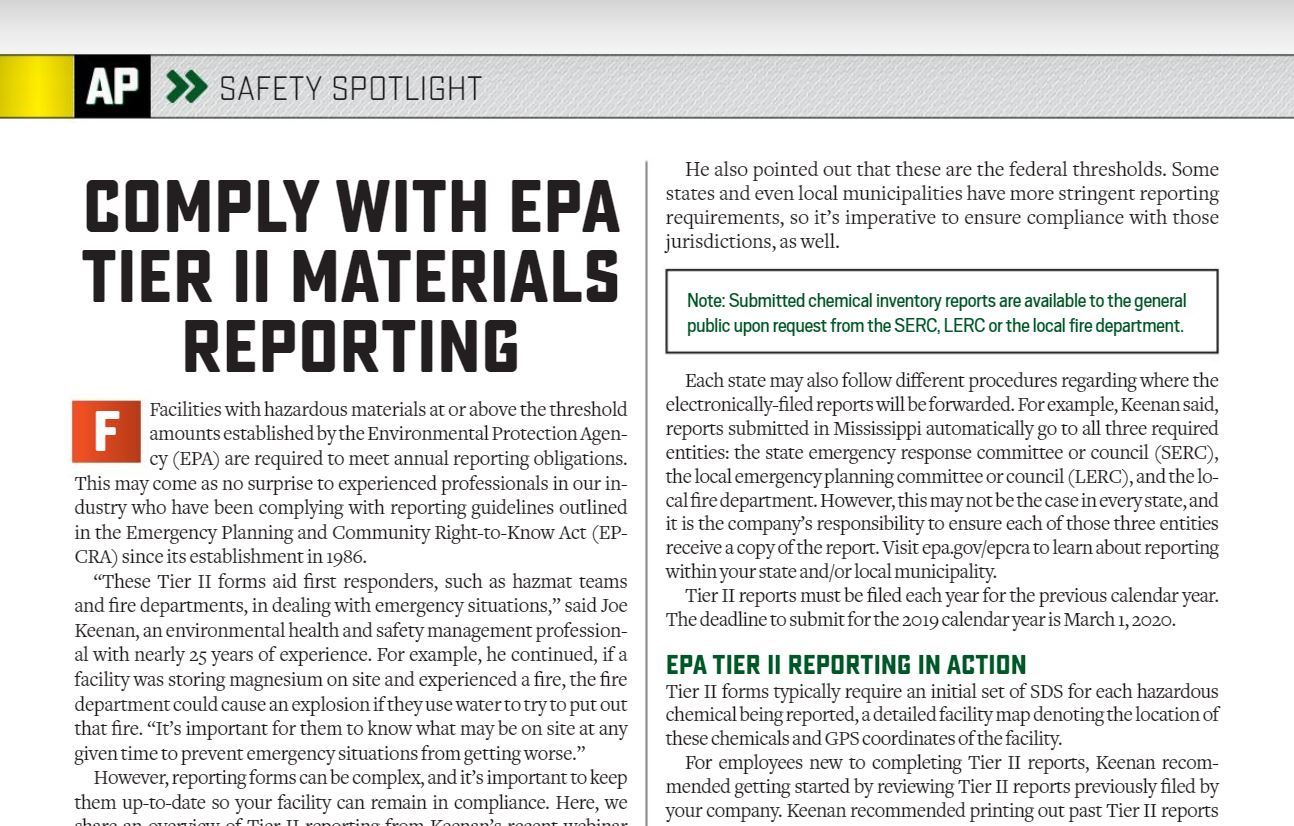Comply with EPA Tier II Materials Reporting
BY AsphaltPro Staff

Facilities with hazardous materials at or above the threshold amounts established by the Environmental Protection Agency (EPA) are required to meet annual reporting obligations. This may come as no surprise to experienced professionals in our industry who have been complying with reporting guidelines outlined in the Emergency Planning and Community Right-to-Know Act (EPCRA) since its establishment in 1986.
“These Tier II forms aid first responders, such as hazmat teams and fire departments, in dealing with emergency situations,” said Joe Keenan, an environmental health and safety management professional with nearly 25 years of experience. For example, he continued, if a facility was storing magnesium on site and experienced a fire, the fire department could cause an explosion if they use water to try to put out that fire. “It’s important for them to know what may be on site at any given time to prevent emergency situations from getting worse.”
However, reporting forms can be complex, and it’s important to keep them up-to-date so your facility can remain in compliance. Here, we share an overview of Tier II reporting from Keenan’s recent webinar presented by ComplianceKey, an online portal of Ijona Services LLC, offering compliance training on a variety of topics, including risk management, corporate compliance, and other regulatory compliances.
EPA Tier II Reporting Background
Sections 311 and 312 in EPCRA require companies to report hazardous chemicals at their facilities if those materials meet a specified threshold. This applies to any chemicals subjected to the Globally Harmonized System of Classification and Labelling of Chemicals, or GHS.
As outlined in section 311, Keenan pointed out that the company must maintain an inventory of all hazardous chemicals on site and complete a Safety Data Sheet (SDS) for each one, regardless of whether or not the total amount of that material requires Tier II reporting.
Tier I and Tier II reporting is outlined in section 312. Hazardous chemicals must be reported if quantities exceed 10,000 pounds. Extremely hazardous substances (EHSs) must be reported if quantities exceed 500 pounds, or that particular substance’s threshold planning quantity.
If quantities surpass these thresholds for even one day of the year at your facility, it must be reported. Note that hazardous chemicals can include raw materials, in-process quantities, products and waste materials. “You must account for all quantities present in all materials, mixtures and stages of production,” Keenan said.
He also pointed out that these are the federal thresholds. Some states and even local municipalities have more stringent reporting requirements, so it’s imperative to ensure compliance with those jurisdictions, as well.
Inset: Note: Submitted chemical inventory reports are available to the general public upon request from the SERC, LERC or the local fire department.
Each state may also follow different procedures regarding where the electronically-filed reports will be forwarded. For example, Keenan said, reports submitted in Mississippi automatically go to all three required entities: the state emergency response committee or council (SERC), the local emergency planning committee or council (LERC), and the local fire department. However, this may not be the case in every state, and it is the company’s responsibility to ensure each of those three entities receive a copy of the report. Visit epa.gov/epcra to learn about reporting within your state and/or local municipality.
Tier II reports must be filed each year for the previous calendar year. The deadline to submit for the 2019 calendar year is March 1, 2020.
EPA Tier II Reporting In Action
Tier II forms typically require an initial set of SDS for each hazardous chemical being reported, a detailed facility map denoting the location of these chemicals and GPS coordinates of the facility.
For employees new to completing Tier II reports, Keenan recommended getting started by reviewing Tier II reports previously filed by your company. Keenan recommended printing out past Tier II reports and comparing quantities and substances present on-site with those documents, noting any changes.
Beginners, or those wishing to refresh their knowledge, can attend an EPA online tutorial at epa.gov/epcra.
To develop a comprehensive chemical inventory management system, Keenan recommended starting with the company’s purchasing department or inventory department to get records, ask questions and request they provide the information needed going forward. Then, he suggested doing a comprehensive walk-through of the facility to take inventory and make detailed notes of all substances on site, where and how they are stored, and any other pertinent information. Commonly overlooked items, Keenan said, often include bulk fuel storage, sulfuric acid in lead acid batteries and chemicals stored in small amounts in various locations within the facility, such as oils in equipment or compressed gas cylinders. He also recommended having a detailed process to approve new chemicals that come on site.
“It’s important to have records of what is being stored in your facility,” Keenan said. “Even if you’ve determined that you don’t need to report a particular chemical if it falls under the threshold, it’s good to document it in your records in case you are ever audited by the EPA or the state department of environmental quality or environmental resources so you have the data to back up any claims that it was under those thresholds.”
This process must be done at every facility, in every state and/or municipality in which a company operates.
Once you submit your report, Keenan recommended documenting the acknowledgement of receipt for your records.
